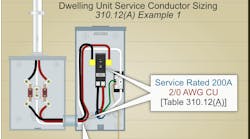EC&M Tech Talk Video — Five Practical Steps for Performing Electrical Work Safely
In this episode of “EC&M Tech Talk,” Randy Barnett, an electrical instructor, trainer, inspector, journeyman electrician, and safety expert, walks viewers through five practical steps for performing electrical work safely by creating an electrically safe work condition.
Whether you are the qualified electrical worker doing the job, the apprentice learning the trade, or the manager responsible for electrical safe work, this Tech Talk puts into perspective the myriad of requirements of the NFPA 70E Standard for Electrical Safety in the Workplace.
Randy first begins by pointing out to those responsible for an electrical safety program the requirements of NFPA 70E Sec. 110.5, Electrical Safety Program. The program must be documented and contain the elements specified in this section. The electrical safety program must be reviewed every three years.
The Tech Talk then takes viewers through the five basic safety steps for accomplishing electrical work safely:
- Perform a risk assessment. Both shock and arc flash risk assessments are required. They must be documented. Each assessment identifies the specific hazard (voltage levels for shock assessment and incident energy levels and working distances for arc flash assessment). Once the hazard is identified, the likelihood and severity of each task required for the performance of the job is documented. If the job cannot be performed safely, the third step of the risk assessment requires identifying the methods to be used to reduce the task to a safe level.
- Select electrical personal protective equipment (PPE) based on the results of the risk assessment. All parts of the body must be protected. PPE must be inspected and properly donned prior to use.
- Verify equipment is suitable for normal operation by referring to the six requirements specified in NFPA 70E.
- Establish boundaries and set up protection barricades. The barricade must be set at the limited approach boundary (based on voltage) or the arc flash boundary (based on incident energy) — whichever is greater.
- Establish an electrically safe work condition by following your company's electrical lockout/tagout policy based on the requirements of NFPA 70E Art. 120, Creating an Electrically Safe Work Condition.
Be sure to voice your opinion or ask questions in the comment section below. And check back for next month’s edition of “EC&M Tech Talk,” which will focus on boxes.
Randy Barnett is the electrical codes and safety program manager for NTT Training in Centennial, Colo.



